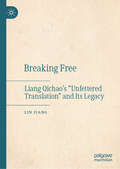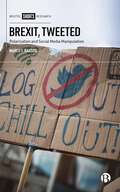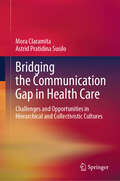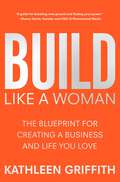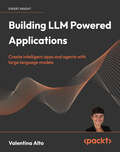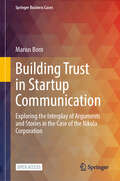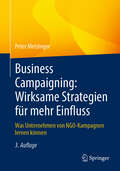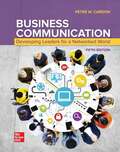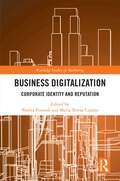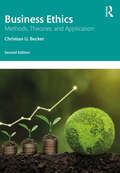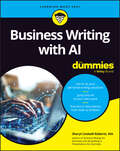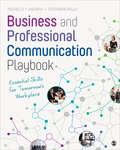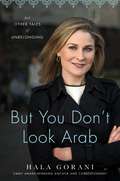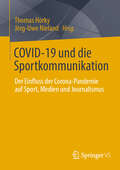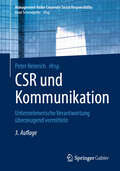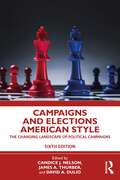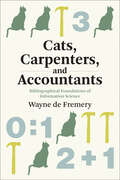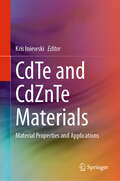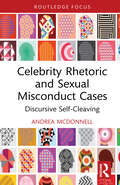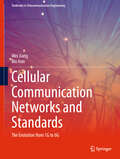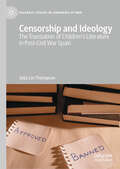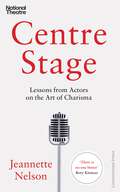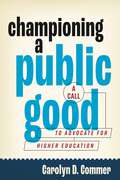- Table View
- List View
Breaking Free: Liang Qichao’s “Unfettered Translation” and Its Legacy
by Lin JiangThis book deeply examines the definition, formation, translation purpose, stylistic features, and modernity connotation of Liang’s “unfettered translation.” The book on Liang Qichao and his “unfettered translation” is the first of its kind in academia. This translation strategy, first adopted by Liang, played a crucial role in introducing Western learning and influencing late Qing Dynasty translators. Reflecting Liang’s political agenda, it aims to save the country and enlighten the people, promoting societal modernization and cultural exchange. The book offers Western readers insights into Liang Qichao’s translation and its impact on modern Chinese culture.
Brexit, Tweeted: Polarization and Social Media Manipulation
by Marco BastosDissecting 45 million tweets from the period that followed the Brexit referendum, this book presents an extensive analysis of social media manipulation. The book examines emerging changes in partisan politics, nationalist and populist values, as well as broader societal changes that are feeding into polarization and echo-chamber communication. It pulls the curtain back on the techniques employed to interfere with, and potentially distort, the public discussion. Making complex data accessible to non-technical audiences, this unique post-mortem of the Brexit referendum contributes to our understanding of social media disinformation in the UK and beyond.
Bridging the Communication Gap in Health Care: Challenges and Opportunities in Hierarchical and Collectivistic Cultures
by Mora Claramita Astrid Pratidina SusiloThis book discusses how hierarchical and collectivist cultures contribute to the challenges and opportunities in communication in health care. Failures in communication may result in threats to patient safety. The work is structured around the Hofstede theoretical framework, focusing on two of the six domains of culture, namely hierarchy and collectivism. To date, guidelines on communication practices in health care have been primarily based on Western evidence and thus do not satisfy the needs of other cultural contexts. Existing studies have shown that strong hierarchical and collectivist cultures, transnationally, have different communication practices, with shared characteristics between several countries in Asia, Africa, and South America. Furthermore, when people migrate, they bring their communication styles — which reflect their cultural characteristics — to their new host environment. When not well managed, these differences can yield problematic communication gaps affecting patient care. Building on their extensive work focused on healthcare communication in Southeast Asian cultures, the authors propose remedial approaches and discuss future initiatives for practicing doctors, nurses, pharmacists, and other healthcare practitioners who encounter the daily struggle of cultural miscommunication in their clinical practices. They also address the ways in which patients experience hesitancy when communicating with healthcare providers, owing to cultural barriers. The book proposes how healthcare providers might tackle these communication challenges. It is relevant to educators and researchers in medical and health professions education and public health, and for all patients' advocates, who are looking to enhance their communication skills to improve patient care and safety.
Build Like A Woman: The Blueprint for Creating a Business and Life You Love
by Kathleen GriffithFrom the self-made businesswoman and founder of the global platform Build Like A Woman comes the essential resource to unleash your business, take up space, and create your dream life.In a world of hustle culture and burnout, women don’t want to lean in, they want to lie down. Now more than ever, women are looking to leave the corporate grind to break out into their own entrepreneurial ventures in a way that feeds their life rather than consumes it. But they don’t know exactly where to start.Kathleen Griffith has been in these exact shoes. When she set out to launch her own business she found that the women’s business space was big on “go, girl” messages, but short on the gritty details of actually building a business. So she taught herself everything she could, learned from the best minds in business and coached with personal growth experts. She realized, shockingly, that all the “mindset” work paid the highest dividends of all in her business, and that through this process she had developed a proven method for success.Blending foundational mindset tenets with the practical, actionable, business-building skillsets, Build Like A Woman is for aspiring and existing entrepreneurs who want to start and scale a business AND life they love. From corporate dropouts to side hustlers to recent college grads to full-fledged founders. This is not a regular business book, but an unconventional blueprint for creation. It will shake up any belief that’s holding you back, remove any barriers standing in your way and unlock your full potential. Tools you’ll get to break ground in business and break through in life:● Life Design● Wellness Practices ● Personal Power ● Mindful Leadership ● Money Management ● Customer Target● Brand Strategy● Marketing Plan● Sales Pitch Are you ready to BUILD? Let’s dig in.
Building Cybersecurity Applications with Blockchain and Smart Contracts (Signals and Communication Technology)
by Emmanuel Bertin Nour El Madhoun Ioanna DionysiouThis book offers an in-depth exploration of the application of blockchain and smart contract technologies in the field of cybersecurity. It begins by defining the fundamentals of cybersecurity in the context of blockchain and smart contracts, and then moves on to the world of e-government services, describing how blockchain can enhance the security of these services. The book also explores how blockchain can secure the Internet of Things (IoT), focusing on applications such as securing drones and protecting robotic networks. The importance of scalability in distributed replication systems is also discussed, with a particular focus on sharding. Finally, the book looks at the challenges of data protection in distributed ledger and blockchain technologies, providing both an analysis of the problems and solutions. Written by academic researchers and industry experts, this book offers a comprehensive and nuanced perspective on the transformational potential of blockchain and smart contracts in the field of cybersecurity.
Building LLM Powered Applications: Create intelligent apps and agents with large language models
by Valentina AltoGet hands-on with GPT 3.5, GPT 4, LangChain, Llama 2, Falcon LLM and more, to build LLM-powered sophisticated AI applicationsKey FeaturesEmbed LLMs into real-world applicationsUse LangChain to orchestrate LLMs and their components within applicationsGrasp basic and advanced techniques of prompt engineeringBook DescriptionBuilding LLM Powered Applications delves into the fundamental concepts, cutting-edge technologies, and practical applications that LLMs offer, ultimately paving the way for the emergence of large foundation models (LFMs) that extend the boundaries of AI capabilities. The book begins with an in-depth introduction to LLMs. We then explore various mainstream architectural frameworks, including both proprietary models (GPT 3.5/4) and open-source models (Falcon LLM), and analyze their unique strengths and differences. Moving ahead, with a focus on the Python-based, lightweight framework called LangChain, we guide you through the process of creating intelligent agents capable of retrieving information from unstructured data and engaging with structured data using LLMs and powerful toolkits. Furthermore, the book ventures into the realm of LFMs, which transcend language modeling to encompass various AI tasks and modalities, such as vision and audio. Whether you are a seasoned AI expert or a newcomer to the field, this book is your roadmap to unlock the full potential of LLMs and forge a new era of intelligent machines.What you will learnExplore the core components of LLM architecture, including encoder-decoder blocks and embeddingsUnderstand the unique features of LLMs like GPT-3.5/4, Llama 2, and Falcon LLMUse AI orchestrators like LangChain, with Streamlit for the frontendGet familiar with LLM components such as memory, prompts, and toolsLearn how to use non-parametric knowledge and vector databasesUnderstand the implications of LFMs for AI research and industry applicationsCustomize your LLMs with fine tuningLearn about the ethical implications of LLM-powered applicationsWho this book is for Software engineers and data scientists who want hands-on guidance for applying LLMs to build applications. The book will also appeal to technical leaders, students, and researchers interested in applied LLM topics. We don’t assume previous experience with LLM specifically. But readers should have core ML/software engineering fundamentals to understand and apply the content.
Building Trust in Startup Communication: Exploring the Interplay of Arguments and Stories in the Case of the Nikola Corporation (Springer Business Cases)
by Marius BornThis open access book explores the intriguing narrative of Nikola Corporation's startup journey in this insightful case study, examining its rapid ascent and subsequent decline from both a narrative and argumentative perspective. Founded by Trevor Milton, Nikola initially garnered investor interest with promises of a cleaner, sustainable alternative to diesel trucks. However, the company's surge in valuation was short-lived, as accusations from a short seller triggered a trust crisis, exposing alleged deception and raising doubts about the company's technology claims. This case study particularly focuses on the nuances of startup communication, emphasizing the critical importance of effective and trustworthy strategic communication for emerging tech ventures. It provides an in-depth look at the methods and tools necessary for startups to navigate initial skepticism and data limitations without exposing themselves to potential crises. Key insights include crafting compelling startup stories while maintaining trustworthiness, meeting investor information needs in an argumentatively convincing structure, recognizing the risks of blind faith in charismatic founders, and implementing internal checks and balances to safeguard against deception. Nikola's story serves as a cautionary tale, offering valuable lessons for entrepreneurs, investors, and scholars alike. This comprehensive examination sheds light on the challenges faced by startups dependent on emerging technologies and ambitious promises, making it an indispensable addition to the reading list of entrepreneurs.
Business Campaigning: Was Unternehmen von NGO-Kampagnen lernen können
by Peter MetzingerDieses Buch ist die dritte Auflage von Business Campaigning, einem 1998 durch Peter Metzinger entwickelten Konzept. Es basiert auf der Erfahrung des Autors aus mehr vier Jahrzehnten Campaigning-Praxis auftun ist dabei auch stark vom Denken des Physikers geprägt. Business Campaigning ist ein Meta-Konzept, das dabei hilft, die öffentliche Meinung oder das Verhalten von Zielgruppen zu beeinflussen, um geschäftliche oder politische Ziele zu erreichen. Es umfasst die Planung und Durchführung von Veränderungsprozessen – auch Kampagnen sind Veränderungsprozesse –, mittels einer Systematik, die sowohl für Politik, als auch Change Management, Marketing und Unternehmenskommunikation geeignet ist. Der Schlüssel zum erfolgreichen Business Campaigning liegt in der systematischen und strukturierten Vorgehensweise.
Business Communication: Developing Leaders for a Networked World
by Peter CardonIn Business Communication: Developing Leaders for a Networked World, Peter Cardon is taking a practitioner and case-based approach to help students develop an understanding of how course content applies to the business world. Maintaining a central theme of credibility, the author communicates why credibility is essential to effective communication. Integrated with Connect for Business Communication, Cardon provides a contemporary yet traditional view into the field, empowering students to learn bedrock communication principles while also staying up-to-date with cultural and technological changes in the business world—transforming them into leaders for a networked world.
Business Digitalization: Corporate Identity and Reputation (Routledge Studies in Marketing)
by Pantea Foroudi Maria Teresa CuomoTechnological advances, alongside increasing globalization and growing awareness of socio-cultural and socio-political issues, are driving corporate branding innovations, and organizations must react and adapt quickly to compete. This book investigates and explores the impact of digital transformation on building corporate branding, identity and reputation. This book brings together international contributors to provide examples from a wide range of industries and firms, including the retailing and agrifood industries, and illustrates the many dimensions of corporate branding and theories and how they can be aided by digital transformation. It explores the connection of branding with artificial intelligence, social media networks and technologies 4.0, as well as the limitations and challenges they might deliver. Using a combination of theory, primary research findings and practice, this book offers viewpoints and expertise from multiple regions, appealing to a global audience. This edited collection serves as an important resource for researchers, scholars and postgraduate students of marketing, brand management and corporate communications and those interested in the emerging relationship with technology.
Business Ethics: Methods, Theories, and Application
by Christian U. BeckerBusiness Ethics: Methods, Theories, and Application provides a new systematic approach to normative business ethics that covers the complex and various ethical challenges of modern business. It aims to train analytical thinking skills in the field of business ethics and to approach ethical issues in business in a rational and systematic way.The book develops a number of specific methods for business ethics analysis that are tailored for ethical decision-making in business and for analyzing complex ethical topics in business. The book discusses fundamental ethical questions regarding the meaning of business and the economy for the individual person, society, the environment, and people around the world.As a result, Business Ethics: Methods, Theories, and Application develops normative guidelines for business in the 21st century and its fundamental challenges and will be key reading for undergraduate, postgraduate, and MBA students of business ethics, business strategy, business and society, and related fields.This second edition is fully updated to recognize the changing nature of ethics and corporate responsibility in a globalized world and includes online support material.
Business Writing with AI For Dummies
by Sheryl Lindsell-RobertsLearn how to generate high quality, business documents with AI This essential guide helps business writers and other professionals learn the strengths and weaknesses of AI as a writing assistant. You'll discover how AI can help you by chopping through writer's block, drafting an outline, generating headlines and titles, producing meaningful text, maintaining consistency, proofreading and editing, and optimizing content for search engines. Employees in all industries spend enormous amounts of energy writing, editing, and proofreading documents of all kinds. Now, you can improve your efficiency and boost the quality of your work, thanks to AI writing tools like ChatGPT, Jaspar, Grammarly, and beyond. With clear instructions and simple tips, Business Writing with AI For Dummies guides you through the process of using AI for common business writing tasks. Produce high quality, specialized writing quicker and at a lower cost Use AI to draft business-related content like emails, articles, business plans, grant proposals, bios, websites, and many others Incorporate AI into your writing process to make your workday more efficient Take advantage of AI so you can focus your human creativity on going beyond the basics For business professionals facing tight deadlines or large volumes of writing tasks, this easy-to-use Dummies guide will be a game changer.
Business and Professional Communication Playbook: Essential Skills for Tomorrow′s Workplace
by Michelle T. Violanti Stephanie E. KellyBusiness and Professional Communication Playbook teaches students the essentials of business communication and necessary skillset that employers look for today. Michelle Violanti and Stephanie Kelly use engaging examples, provide tips on how to carry yourself professionally, and incorporate real-life experiences from recent graduates to teach students how to communicate like a professional. Focused, bite-sized chapters on the most important topics in business communication, such as interviewing, writing resumes, and leading team presentations will motivate students to read and prepare ahead of time so instructors can focus on skill-building during class. By using this simple and flexible format, this text will provide students and instructors with an excellent foundation for a successful Business Communication course. This title is accompanied by a complete teaching and learning package in SAGE Vantage, an intuitive learning platform that instructors and students actually love.
Business and Professional Communication Playbook: Essential Skills for Tomorrow′s Workplace
by Michelle T. Violanti Stephanie E. KellyBusiness and Professional Communication Playbook teaches students the essentials of business communication and necessary skillset that employers look for today. Michelle Violanti and Stephanie Kelly use engaging examples, provide tips on how to carry yourself professionally, and incorporate real-life experiences from recent graduates to teach students how to communicate like a professional. Focused, bite-sized chapters on the most important topics in business communication, such as interviewing, writing resumes, and leading team presentations will motivate students to read and prepare ahead of time so instructors can focus on skill-building during class. By using this simple and flexible format, this text will provide students and instructors with an excellent foundation for a successful Business Communication course. This title is accompanied by a complete teaching and learning package in SAGE Vantage, an intuitive learning platform that instructors and students actually love.
But You Don't Look Arab: And Other Tales of Unbelonging
by Hala GoraniEmmy Award-winning international journalist Hala Gorani weaves stories from her time as a globe-trotting correspondent and anchor with her own lifelong search for identity as the daughter of Syrian immigrants. What is it like to have no clear identity in a world full of labels? How can people find a sense of belonging when they have never felt part of a &“tribe?&” And how does a blonde-haired, blue-eyed woman who&’s never lived in the Middle East honor her Arab Muslim ancestry and displaced family—a family forced to scatter when their home country was torn apart by war? Hala Gorani&’s path to self-discovery started the moment she could understand that she was &“other&” wherever she found herself to be. Born of Syrian parents in America and raised mainly in France, she didn&’t feel at home in Aleppo, Seattle, Paris, or London. She is a citizen of everywhere and nowhere. And like many journalists who&’ve covered wars and conflicts, she felt most at home on the ground reporting and in front of the camera. As a journalist, Gorani has traveled to some of the most dangerous places in the world, covering the Arab Spring in Cairo and the Syrian civil war, reporting on suicide bombers in Beirut and the chemical attacks in Damascus, watching the growth of ISIS and the war in Iraq—sometimes escaping with her life by a hair. But through it all, she came to understand that finding herself meant not only looking inward, but tracing a long family history of uprooted ancestors. From the courts of Ottoman Empire sultans through the stories of the citizens from her home country and other places torn apart by unrest, But You Don&’t Look Arab combines Gorani&’s family history with rigorous reporting, explaining—and most importantly, humanizing—the constant upheavals in the Middle East over the last century.
COVID-19 und die Sportkommunikation: Der Einfluss der Corona-Pandemie auf Sport, Medien und Journalismus
by Jörg-Uwe Nieland Thomas HorkyCOVID-19 hat die Sportkommunikation nachhaltig verändert. Der Band bietet empirische Analysen, Einschätzungen und theoretische Ansätze sowie Erfahrungsberichte aus der Praxis zum Einfluss der Corona-Pandemie auf Medien, Journalismus und Sport. Aus unterschiedlichen Perspektiven schauen Wissenschaftlerinnen und Wissenschaftler sowie Personen aus der Praxis auf die Veränderungen in verschiedenen Medien- und Sportorganisationen sowie den Wandel von Produktions- und Arbeitsbedingungen innerhalb der Sportkommunikation. Gleichzeitig lassen sich erste Prognosen für einen Ausblick auf die Zukunft des Mediensports ableiten.
CSR und Kommunikation: Unternehmerische Verantwortung überzeugend vermitteln (Management-Reihe Corporate Social Responsibility)
by Peter HeinrichDiese aktualisierte und überarbeitete 3. Auflage liefert einen fundierten, praxisbezogenen Überblick über die Kommunikationsinstrumente und -möglichkeiten sowie den Planungsprozess im Bereich CSR. Das Buch ist ein Ideenkatalog und vermittelt zugleich auch das wissenschaftliche Hintergrundwissen. Die Beiträge wurden den aktuellen Entwicklungen angepasst und erweitert. Der Praxisteil des Werkes wurde um noch mehr Best-Practice-Beispiele aus unterschiedlichsten Branchen ergänzt. 26 Praxisbeiträge aus verschiedenen Branchen zeigen, wie die CSR-Kommunikation wirksam angewendet wird. Viele Unternehmen engagieren sich heute gesellschaftlich und übernehmen Verantwortung. Ein sinnvoller Schritt, denn so leisten sie einen Beitrag zur gesamtwirtschaftlichen Nachhaltigkeit, prägen ihr Image und generieren dabei gezielt Wettbewerbsvorteile. Ein wichtiger Schlüssel zum Erfolg liegt dabei in der Kommunikation. „Tue Gutes und sprich darüber“ – es geht um die Kommunikation mit allen relevanten Dialoggruppen. In diesem Zusammenhang gibt dieses Buch den Menschen, die sich mit CSR beschäftigen – ob auf Unternehmens- oder Beraterseite, ob als Newcomer oder als Experte – Orientierung, Impulse und Handlungsempfehlungen für die tägliche Praxis.
Campaigns and Elections American Style: The Changing Landscape of Political Campaigns
by James A. Thurber Candice J. Nelson David A. DulioWith new and revised chapters throughout, the sixth edition of Campaigns and Elections American Style allows academics and campaign professionals the chance to explain how the COVID-19 pandemic, 2020 general election, and 2022 midterm election upended the campaign process and changed the landscape of political campaigns forever. Offering a unique and careful mix of Democrat and Republican, academic and practitioner, and male and female campaign perspectives, this volume scrutinizes national and local-level campaigns. Students, citizens, candidates, and campaign managers learn not only how to win elections but also why it is imperative to do so in a safe and ethical way. Perfect for a variety of courses in American government, this book is especially valuable to schools of campaign management and campaign professionals working at every level from the local to the global. Highlights of the Sixth Edition Covers the 2020 and 2022 elections with an eye to 2024. Examines changes to the campaign process as a result of COVID-19 and puts them in context with campaign traditions over time. Includes a new organization that moves campaign finance up front to emphasize the centrality of fundraising to successful campaigns. Offers more data to inform campaign planning and management, especially related to key topics such as the change in news media coverage, the growth and use of social media, the use of "big data" in campaigns, and changes in field and voting rules and policies.
Cats, Carpenters, and Accountants: Bibliographical Foundations of Information Science (History and Foundations of Information Science)
by Wayne de FremeryAn expansive case for bibliography as infrastructure in information science.Cats, Carpenters, and Accountants argues that bibliography serves a foundational role within information science as infrastructure, and like all infrastructures, it needs and deserves attention. Wayne de Fremery&’s thoughtful provocation positions bibliography as a means to serve the many ends pursued by information scientists. He explains that bibliographic practices, such as enumeration and description, lie at the heart of knowledge practices and cultural endeavors, but these kinds of infrastructures are difficult to see. In this book, he reveals them and the ways that they formulate information and meaning, artificial intelligence, and human knowledge.Drawing on scholarship from areas as diverse as data science, machine learning, Korean poetry, and the history of bibliography, de Fremery makes the case for understanding bibliography as a generative mode of accounting for what has been received as data, what he calls &“carpentry-accounting.&” Referencing a well-known debate in the Anglo-American bibliographical tradition that features a willful cat, he suggests that bibliography and bibliographers are intentionally marginal figures who, paradoxically, perform foundational work in the service of the diverse disciplinary ends that formulate, however loosely, information science as a field. When we attend to the marginal but essential work of accounting for what humankind has fashioned as recorded knowledge, it becomes easier to consider the ways that human accounts can serve and, sometimes, injure us. Relevant to scholars and students from the sciences to the humanities, Cats, Carpenters, and Accountants is a highly original argument for bibliography as a marginal but foundationally powerful force shaping information science as a field and the ways that we know.
CdTe and CdZnTe Materials: Material Properties and Applications
by Kris IniewskiThis book provides readers with a good overview of some of most recent advances in the field of CdTe and CdZnTe detector technology for medical imaging, industrial testing and security scanning, especially as it pertains to new applications. There will be a good mixture of general chapters in both technology and applications inthe X-ray testing. The book will have an in-depth review of the research topics from leading world specialists in the field. The conversion of the X-ray and gamma-ray signal into analogue/digital value will be covered in some chapters. Some would also provide a review of CMOS chips for CdTe and CdZnTe image sensors. This book serves as an excellent reference for people already working in the field as well as for people wishing to enter it.
Celebrity Rhetoric and Sexual Misconduct Cases: Discursive Self-Cleaving (Routledge Focus on Communication Studies)
by Andrea McDonnellThis book considers the rhetorical strategies used by celebrities and their surrogates and attorneys when faced with claims of sexual misconduct.During the past five years, a series of public figures has claimed that their celebrity persona is distinct from their “real” self as a way of eluding allegations of sexual misconduct in the courthouse and in the court of public opinion. This book examines three case studies in which such claims were employed, namely Terry Bollea/Hulk Hogan, President Donald Trump/Reality Show Host Donald Trump, and R. Kelly/Robert Kelly, to assess the mediated and legal communicative strategies used and their potential implications. Using a technique which the author calls “discursive self-cleaving,” these stars strategically craft statements on social media, in the press, and in the courtroom to create a discourse that works to shift blame away from their behavior. The book also traces the relationship between these discursive approaches and the politics of sexual violence and domestic abuse during the early months of the #MeToo movement and beyond.Providing a richly detailed analysis of how this discourse functions and why jurors and members of the public find it convincing, this book will be of interest to students and scholars in the field of communication studies, rhetoric, media, law, and popular culture studies.
Cellular Communication Networks and Standards: The Evolution from 1G to 6G (Textbooks in Telecommunication Engineering)
by Wei Jiang Bin HanThis textbook provides a comprehensive review of the evolution of mobile communications and networking from the birth of cellular networks to the forthcoming sixth-generation mobile communications, which is envisioned to be commercially deployed first in 2030. New students who are coming to wireless communications/electrical engineering/computer networking/telecommunications and network engineering can benefit from this book by quickly grasping the whole history of cellular networks, understanding its trends. This tutorial styled textbook provides a comprehensive overview, but also provides details of the system design aspects of the various cellular generations up to 6G and how they build on each other. The book also gives the student an overview of different cellular generations’ motivations, core technologies, architecture, key performance indicators, killer applications, market drivers, and the general/main features of each. The authors capture the big picture and fundamental drivers of wireless communication technologies, and then motivate students to understand the importance of learning related subjects such as electromagnetics theory, antenna design, analog and digital circuits, signal processing, Internet protocols, artificial intelligence, etc. The book features homework questions and case studies throughout.
Censorship and Ideology: The Translation of Children's Literature in Post-Civil War Spain (Palgrave Studies in Languages at War)
by Julia Lin ThompsonThis book offers a fascinating picture of how state censorship affected children’s literature translation in post-Civil War Spain. Focusing on the Spanish translations of Mark Twain’s children’s classics The Adventures of Tom Sawyer and The Adventures of Huckleberry Finn, the author traces the evolution of the censorship system of the Francoist regime and its impact on Spanish children’s literature during the years after the Spanish Civil War. Drawing on the regime’s censorship laws, official censors’ records, and textbooks, she not only examines the censorship imposed on the translations of Twain’s works, but also offers insights into the intricate connections between state censorship and the regime’s educational aims. The book gives a revealing analysis of the ways in which the highly bureaucratic censorship apparatus operated under Franco’s dictatorship, outlining the flaws and fallacies within it, as well as the strategies adopted by publishers and translators to resist the power of the state. While centred on Francoist Spain, the book also explores broader themes of ideology, censorship, and translation, making it a valuable source for scholars of translation studies and Hispanic studies, as well as those with a wider interest in literature, history, and cultural studies.
Centre Stage: Lessons from Actors on the Art of Charisma
by Jeannette NelsonHow the world’s best actors communicate with gravitas – and how you can, too.‘The theatre stars’ voice guru’ Daily MailActing is all about charisma. Whether you’re an A-list star or an extra, when you’re on stage you need to perform in a way that makes your audience listen.That stage presence is something we can all learn from. Every time you speak up in a meeting, recount an anecdote, or tell a joke, it’s essential to communicate with gravitas.Jeannette Nelson knows a thing or two about gravitas. As Head of Voice at the National Theatre, she has spent three decades working with the world’s leading actors – from Al Pacino to Benedict Cumberbatch to Juliette Binoche – teaching them to speak clearly and move confidently.Now, Nelson pulls back the curtain on the tricks that professional performers use to own the room. Starting with clear speech and good posture, before moving on to the art of rhetoric and overcoming stage fright, she outlines a holistic three-stage method to communicating with authority, authenticity and eloquence. Throughout, she peppers the book with stories of how world-renowned actors learnt to make themselves heard – and how you can, too.The result is a fascinating and eminently practical guide to the art of performance. If all the world’s a stage, then this book will turn you into its lead actor.
Championing a Public Good: A Call to Advocate for Higher Education (Rhetoric and Democratic Deliberation)
by Carolyn D. CommerFrom decreased funding to censorship controversies and rising student debt, the public perception of the value of higher education has become decidedly more negative. This crisis requires advocacy and action by policymakers, educators, and the public. Championing a Public Good presents a clear set of strategies and tools for advocates making the case for renewing our civic commitment to public higher education.Taking a fresh look at one of the most controversial moments in the history of US higher education, the work of the Spellings Commission (2005–2008), Carolyn D. Commer argues that this body’s public criticisms of higher education and its recommendation to increase accountability and oversight—via market-based metrics—accelerated the erosion of the concept of higher education as a public good. Countering that requires a careful, forceful approach on the part of advocates. Commer draws from the public record to demonstrate a common set of arguments, metaphors, and rhetorical frames that can, in fact, flip the public debate over higher education to champion the public value of universities and colleges over their value as market commodities.Championing a Public Good is a powerful primer on how to change the course of public higher education in the United States. It will appeal especially to faculty, administrators, and policymakers in higher education.
